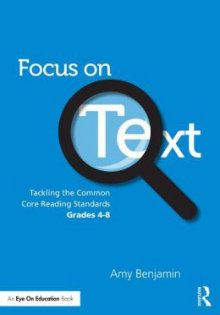Benjamin’s Helpful Guide to Reading Standards
Focus on Text: Tackling the Common Core Reading Standards 4-8
By Amy Benjamin
(Routledge, 2014 – Learn more)

As I began to preview Focus on Text: Tackling the Common Core Reading Standards Grades 4-8, I was excited but wary.
The excitement lay in the idea that I might have finally found a guide through the treacherous pathways that comprise the Common Core Standards, at least in the reading area. My wariness came from a concern that I might be disappointed and find more questions than answers. I’m pleased to say that upon finishing this book, my hopes were realized, not dashed.

What I like best about Focus on Text is it does what my own school district has so far failed to do: give a blow-by-blow account of what should happen in each level. I’ve begged for years to have vertical meetings with the teachers in the grades below my 7th and 8th grade classroom. I want to make sure they know what is expected when students reach middle school, just as I know what the high school teachers expect. This will be an outstanding resource to jump-start that process. One of the best ways to open new conversations is by considering new ideas, which this book provides.
How the book is organized
Benjamin leads into each standard by breaking it down and also showing what comes before 4th grade and after 8th grade. There are examples of how to help students demonstrate knowledge of each standard, and it’s nice to see the progression through the grades.
The other real benefit is the inclusion of some ideas to link the reading standards, through particular assignments, with the writing and the language standards. Too often we become burdened with the sheer enormity of the amount of standards; Benjamin helps show links where you can kill two or even three birds with one stone.
An area that is disappointing, especially in an education book, is the lack of proofreading. I was barely to page five and had found three glaring errors already. More popped up throughout the book. These are not just English geek exceptions to rules, but missing words and punctuation. I find it hard to imagine publishing a book without multiple sets of eyes looking and spotting these easy-to-find mistakes. (I hope someone looks over this review before publishing it too!)
That, however, is a minor complaint. Overall, this is a good book for any educator who teaches reading in grades 4-8. It would be great to see a follow-up book that maps out the other Common Core standards and includes the same sort of helpful examples. It’s also nice, as an educator, to see examples that reflect ideas that have worked in your own classroom.
The Common Core Standards don’t seem to be disappearing, so books like this are a gold mine to reading teachers everywhere.
Mark A. Domeier has taught middle school English at the New Richland-Hartland-Ellendale-Geneva school district in southern Minnesota for 19 years. He also coaches, officiates, and serves as Voice of the Panthers for varsity events. In addition, Domeier stays active as a writer, having self-published two books: Heroics 101 and its sequel Heroics 201, superhero books about college students. He also writes a weekly column for his community newspaper called “Whatever Flips Your Waffle”.




























